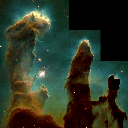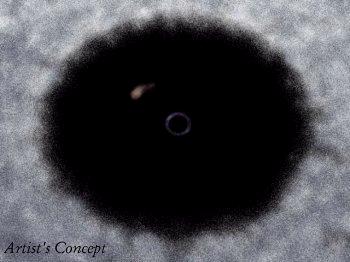

Stellar Birth
Stars are born through nuclear fusion, similar to a controled hydrogen bomb explosion. Stars frequently begin in large clouds of hydrogen such as those at the right. For example, in the Orion Nebula (upper), atoms and particles in the cloud of gas have come close enough to exert gravitational pull on one another, bringing them even closer. Soon, the atoms begin to collide more and more frequently. According to the laws of gravity, the closer they are, the stronger the attraction. Therefore, after many collisions, temperatures rise sufficiently for the nuclei such as hydrogen nuclei to merge with one another. This process is nuclear fusion. An entire area in the cloud of, frequently hydrogen, may pull itself together, forming a star. Continous fusion, and the release of heat thereby, causes the star to shine.
Stellar Death
Once a star runs out of its nuclear fule, it begins to collapse upon itself due to gravity. The way a star ends up depends on its original size. A small star, such as our sun, will become a white dwarf. The exclusion principle (see Vocab.) will continue to keep the star from collpasing beyond a certain size. It becomes a white dwarf. A larger star with a mass above the Chandrasekhar limit will become a neutron star. In a case like this, the star ends its existance as a star in a huge explosion known as a Type II Supernova. However the core of the star continues to collapse into a very dense area. Protons and electrons in the atoms fuse together into neutrons. The exclusion principles again acts, this time in the neutrons.
An even more massive star, unless it loses much of its mass in a supernova before collapsing, will collapse enirely, becoming a Black Hole. When the idea of Black Holes first emerged, scientist thought of it simply as a theory. No evidence had been found. Stars were presumed to lose enough mass in a supernova to put them in range for a white dwarf. It is possible for a large star to lose enough mass to evade its fate as a Black Hole. However, scientist now understand that a large star is most likely destined to collapse in upon itself to become a Black Hole. This means that its gravitational pull is stronger than the speed of light, thereby pulling even light toward its core. The distance at which light can no longer escape the hole's pull is called the event horizon. According to theory, a star should collapse so far as to become a point, or singularity. Both the event horizon and the singularity are shown at the right. To understand these concepts to there fullset extent, please review the laws of gravity.


